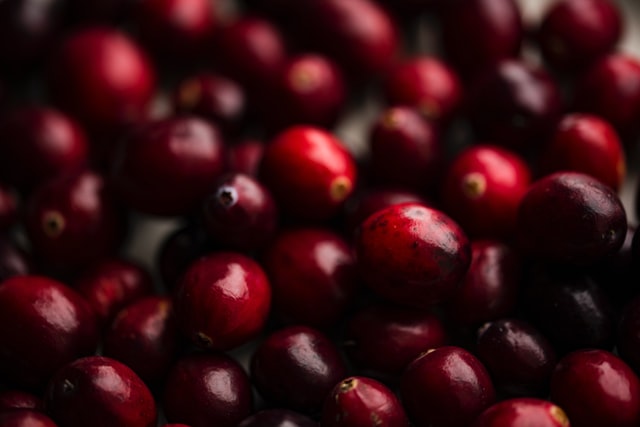Growing Cranberry bushes in the UK provides a lovely ornamental feature for any garden or patio. The bushes also fruit very successfully in the UK climate. They are hardy, mostly pest-free, and they are easy to care for. Native to North America, these bushes are very adaptable and can be grown in containers too.

Cranberries are bursting with goodness, so being able to eat them straight from your own garden is both pleasurable and great for those health benefits. Eat them fresh, have them as a salad topper, in your favourite cereal or why not make some cranberry sauce or pop them in a cake? There are so many uses for cranberries and they can be frozen or dried too.
You can choose the variety of cranberry bush you would like – ranging from upright bushes to trailing varieties. Flowers appear over the summer, making way for the fruit in the Autumn. You will be treated to lovely seasonal colours during the autumn too, with yellows, reds, and purples. You can even opt to plant cranberries into hanging baskets which make a lovely decorative feature too.
There are native cranberry varieties that grow in the wilderness of the UK and can be found by foraging. The varieties are Northern Cranberry (Vaccinium oxycoccus) and Small Cranberry (Vaccinium microcarpus). They are usually situated in lowland bogs as they like damp conditions to grow. Fruits are edible and the plant can be identified by the pink flowers with four backward facing petals.
Jump To...
Growing Cranberry Bushes
Growing cranberry bushes can be very rewarding during the summer and autumn when the flowers and fruit emerge. However, to ensure you get these results, it’s important to carry out those necessary annual tasks.
When To Plant Cranberries
You can plant your cranberries during the dormant winter season so that they have time to establish.
Where To Plant Cranberry Bushes
Cranberry plants appreciate full sun or as much sun as possible. Cranberries are produced quite late in the year so you will want to plant yours somewhere that still gets the sun during the autumn months. You can plant in the ground, in a raised bed, in containers, or in hanging baskets.
How To Plant Cranberry Bushes
How you plant your cranberry bush largely depends on the variety you choose and the method you use.
- Ground-Level: you will need acidic, moist soil in order for cranberries to grow well in the garden. The addition of organic matter will be appreciated by your plant too. If you are planting several of them, leave around 1.2 metres between each. You can plant closer if you are looking to achieve a thick hedge.
- Raised Bed: this doesn’t need to be very high so about 15cm high will work very well. You will be best purchasing some acidic soil and organic matter will help a great deal.
- Pots or hanging baskets: when planting in pots, be sure to use a specialist acidic soil as this is what cranberries need. They like well-moistened conditions so it’s important to keep an eye on them during warm weather.
Cranberry Bush FAQ’s
Still not sure if cranberry bushes are the right fit for your garden, balcony, or patio? Then have a read of our cranberry bush FAQS before making a decision to get yourself a plant and start growing.
Cranberry bushes are self-pollinating but you will get a much bigger crop by planting several if you have the space to do so.
Cranberries flower during the summer making a lovely addition to the garden with the lovely shades of pink.
Cranberries can be harvested during the autumn and they are ready when they’ve turned from yellow to green and then to red. The inner seeds will be brown in the middle when ready to be picked so check just one first.
Cranberries don’t need too much pruning thanks to their low-maintenance status. You need to keep on top of weeding around the area as cranberries do not cope well with weeds. And damaged stems should be removed after the harvesting season. You also want to try and avoid too much overcrowding and trim your bush occasionally to avoid it spilling out.
